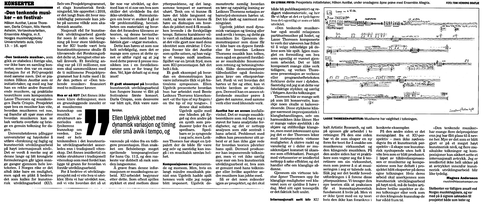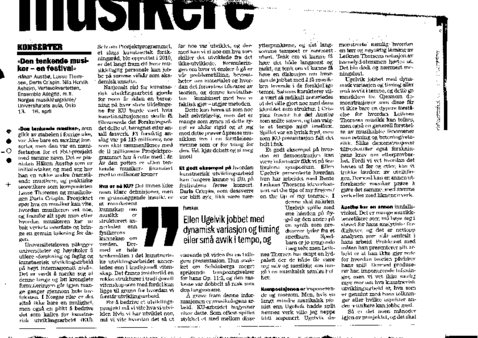Explorative Musicians
Impressive playing: But the project requires musical demonstration of what has actually been developed, and how.
- By Magnus Andersson. Published Monday 20th of April 2015 in Klassekampen - concerts.
«The Reflective Musician – A Festival»
Håkon Austbø, Lasse Thoresen, Darla Crispin, Nils Henrik Asheim, Vertavo Quartet, Ensemble Allegria, et al. Norwegian Academy of Music/ University of Oslo Concert Theatre, Oslo, 13 – 16 April 2015
«The Reflective Musician» festival, held last week in Oslo, was not only a series of concerts, but also a manifestation of the research and development project with the same name. Pianist Håkon Austbø initiated the project, and is joined by a number of prominent musicians and practice-oriented scholars, including composer Lasse Thoresen and musicologist Darla Crispin. The project asks what a musician can know, how a musician acquires knowledge, and, most importantly, it endeavours to investigate how a musician can look beyond the surface of a composition and deliver a genuine interpretation.
The University Act requires universities and university colleges to conduct “research, and scholarly and artistic development work at a high international level". It is worth noting that this long and twisted formulation is repeated many times throughout the Act. Thus, in Norway’s higher educational institutions, so-called “artistic development work” (ADW) is not only a research opportunity but also a duty. Although the Project Programme, a kind of artistic research council, was established in 2010, the conditions of music researchers are still a long way from the terms enjoyed by traditional academic positions. The National Council for Artistic Research a few years ago calculated an estimate of funding necessary to bring ADW at art institutions to a level comparable to the funds administered by the Research Council of Norway, based on annual wage expenses. A modest estimate was 115 m kroner (approx. EUR 14 m), to be compared with this year’s 10 m kroner administered by the Project Programme. From the current funding pool, “The Reflective Musician” was allotted 2 m kroner.
So what is ADW? There are no clear definitions, but a basic understanding of the concept recognizes that a musician’s knowledge of music is fundamentally different from a physicist’s knowledge of the world. Therefore, the very manner of thinking sets artistic development work apart from traditional sciences. However, there are a number of structures within traditional sciences that can aid our understanding of ADW.
In order to carry out a development project one must know what is to be developed. If something is developed, it is important to know what it looked like prior to this development in order to differentiate the developed from the undeveloped. The definition of where we want to go is our research problem, our understanding of the original material and the changes it undergoes corresponds to the theory, and this cognizance – combined with what we actually do – constitutes the method.
This may seem obvious, but many believe such a structure is too rigid and such an understanding attempts to force music into too narrow a conceptual frame. Well, start a debate on the subject and contradict me!
The first concert of the festival might have provided an illuminating live demonstration of how artistic development work is practiced. Darla Crispin was unfortunately indisposed at the time of the concert, but via video of a previous presentation, she talked about Schoenberg’s widely different tempo indications for his Opus 11:2. The fastest is twice as quick as the slowest. Gleaning and investigating such information is a musicologist’s task. ADW begins at the next stage. Usually, the Schoenberg piece is performed at a tempo somewhere between these two extremes, and the slowest tempo is nearly unheard. Imagine hearing both the slow and the quick tempi, as well as a discussion on how the musician worked to bring the music to life at the different tempi. The character of the movement would be so radically different that its very identity and structure would be perceived as essentially altered by the shift in tempo. In Crispin’s absence Austbø performed the movement, and he selected a tempo somewhere between the two extremes. The play was lyrically delightful, but as a demonstration of ADW it failed entirely.
A good example of how a demonstration can be informative was delivered at the festival symposium. Ellen Ugelvik presented her work with Bente Leiknes Thorsen’s piano concerto At the Tips of My Fingers / On the Tip of My Tongue. In this work, the soloist plays the grand piano with one hand, and a synthesizer that produces baby sounds with the other. Babies are musical sounding on their own, but Leiknes Thorsen has created an auditory pallet in which babies’ individual musicality is conveyed at the same time as their sounds form part of a cohesive whole. The composition is impressive and funny. Yet, if a far less musically gifted pianist than Ugelvik had performed this work, I would probably not have been impressed. I learned this from Ugelvik’s additional demonstration of a dry and exact reading of Leiknes Thorsen’s baby sound notation. Such a reading sounded inanimate and meaningless. In Ugelvik’s interpretation, she had worked with dynamic variations, timing, and minor deviations from tempo, which bought the music to life.
Through demonstrations such as this, we gain not only insight into how interpretations of Leiknes Thorsen’s music can vary, but also a general understanding of musical phenomena such as direction and accentuation/rhetoric. Such demonstrations also satisfy the scientific requirement of verifiability. Because we can hear the difference between before and after, we can draw knowledge from the development. With such knowledge, another exploratory musician may attempt the same, with the same or a similar composition.
Austbø has a different approach. His analytical skills exceed those of many music theorists, and his work centres precisely on the analysis. The problem concerns the presentation, in which he fails to explain how theory influences his performance. He produces impressive interpretations, but the audience gains little new insight into what artistic development work entails, what is genuinely new in his rendering, and which aspects other musicians might explore.
A few months remain of the project period, and hopefully the concluding publication(s) and video material will highlight the developments achieved.
“The Reflective Musician” also remodels the traditional notation-musician relation. Lasse Thoresen has composed two works in which the performer has the liberty to select the order of the parts played. Again, we missed a clarification of the developments achieved through the project. Many such works have been composed before, and neither Thoresen’s presentation of his compositions nor the programme text explains this further. At the same time, I must say these are fabulous pieces, especially as interpreted by Vebjørn Anvik.
Thoresen is by many considered conservative, by some even regressive. These compositions sound almost impressionistic with regard to timbre, although the harmonies are dissimilar. Within the delicate and soft tone clusters are many beautiful instants, but what I find most interesting of all is Thoresen’s play with the virtuosic possibilities of the instrument. To compose quick and difficult music is in some musical circles disdained as a striving for effect. However, the very point of virtuosity is to seek effects, some of which are about sonority. Through virtuosic textures, Thoresen opens possibilities of piano sound that are rarely heard today. With its own musical language, this is truly unique.
Internationally, ADW is called “Artistic Research,” and, with only slight exaggeration, one might divide such work into two opposing camps. On the one side are those working to create a new kind of theory for the discussion of musical practice and musical sound. On the other are practitioners who resist theorizing their practice, contending that performance speaks for itself. In my view, the principal challenge consists of uniting these two points of view. We need a new theory in order to provide theory-based knowledge in support of musical practice, but a new theory will not serve its purpose unless anchored in concrete examples. On the other hand, from an ADW perspective (while not necessarily from an artistic perspective) artistic innovation without any concept of what is being produced is meaningless. In the course of the creative process, musicians and composers participating in the project have become experts on their own interpretations. In order to be recognized as artistic research at a high level, their work must better articulate which aspects of their interpretations or works that constitute the musical knowledge they have achieved.
“The Reflective Musician” is comprised of several sub-projects, many of which are not mentioned here. However, a great deal of this work holds a high artistic level, and several interpretations and compositions may well receive international acclaim. However, I am less certain that the artistic research will make an equally notable contribution.
Magnus Andersson
(Translator: Nina Nielsen)
The author is a previous employee of the Norwegian Academy of Music, and participated in the project application both as leader and as a researcher.


